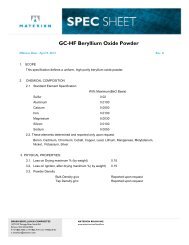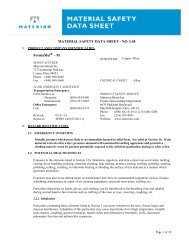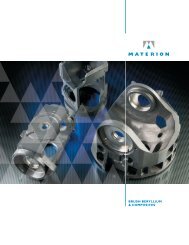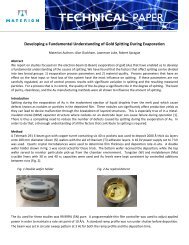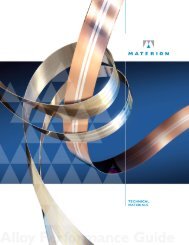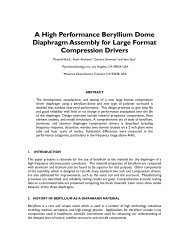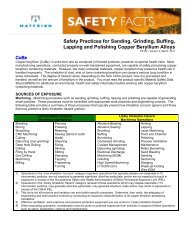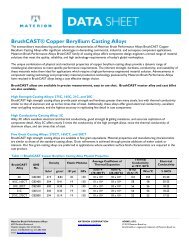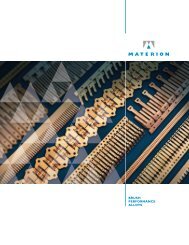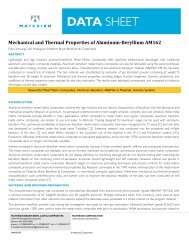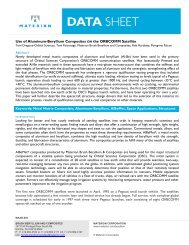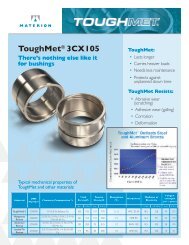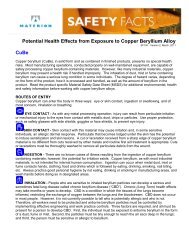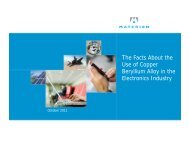AMC640XA PARTICLE REINFORCED ALUMINUM ALLOY - Materion
AMC640XA PARTICLE REINFORCED ALUMINUM ALLOY - Materion
AMC640XA PARTICLE REINFORCED ALUMINUM ALLOY - Materion
Create successful ePaper yourself
Turn your PDF publications into a flip-book with our unique Google optimized e-Paper software.
Particle Reinforced Aluminum Alloy<strong>AMC640XA</strong>Alloy Guide<strong>AMC640XA</strong> is a high quality aluminum alloy (AA6061)reinforced with 40 volume percent ultrafine Silicon Carbideparticles. It is manufactured by a special powder metallurgyroute using a proprietary high-energy mixing process whichensures excellent particle distribution and enhancesmechanical properties.This material offers a high elastic modulus (nearly doublethat of the parent alloy) and good fatigue strength well inexcess of performance aluminum alloys Strength at elevatedtemperatures of greater than 300°C is more than twice theunreinforced alloy. <strong>AMC640XA</strong> offers a combination ofcorrosion resistance and high strength either direct fromprocessing or via solution & aging heat treatments. The keybenefits of <strong>AMC640XA</strong> for high precision applicationsinclude:> High specific stiffness> Wear resistance> Thermal stability> MachinabilityAMC powder metallurgy and mechanical alloying techniques combinethe aluminum alloy (AA6061) matrix with fine (2-3 micron) SiliconCarbide (SiC) particles. Process conditions are controlled to produce aneven distribution of these particles, while maintaining the purity of thematrix alloy. Powders are compacted to fully dense billets by hot isostaticcompaction. Billets are available for direct manufacture to component orfor fabrication by forging or extrusion techniques. Selection of the processroute depends on property requirements, component shape and theresulting process cost.MetalPowderHigh EnergyMixingSoilid StateCompactionBilletCeramicParticlesModulus-to-Weight Ratio (US)0 50 100 150 200<strong>AMC640XA</strong>ExtrusionForgingDirect PowderTechnologyAMC225XEAMC217XESteelTitaniumMagnesiumAluminiumA wide range of machining methods may be applied. High speedmachining with diamond tools achieves excellent surface finish.The combination of properties achieved with <strong>AMC640XA</strong> providesthe potential for outstanding performance in a wide range of marketsand applications including:0 10 20 30 40 50Modulus-to-Weight Ratio (SI)<strong>AMC640XA</strong> Physical PropertiesThermal Conductivity130 W/m/ºCThermal ExpansionCoefficient13.4 ppm/°CElectrical Conductivity21 % IACS (T1)Heat Capacity0.8 J/g/ºCDensity 2.90 g/cm 3<strong>AMC640XA</strong> Mechanical Properties T6(Typical Values, Ext-Long.)Elastic Modulus GPa (Msi) 140 (20)0.2% Yield Strength MPa (Ksi) 480 (70)Ultimate Tensile Strength MPa (Ksi) 570 (83)Elongation % 2.5Poisson’s Ratio 0.3Vickers Hardness HV5 235Fatigue Strength (R=-1, MPa @1x10 7 cycles) 271 (39)Precision and High Speed Machinery> X-Y tables> High stability tooling systems> CNC machinery> Measurement and controlAerospace & Defense> Satellite systems> Instrumentation> Optical structure> ElectronicsAutomotive> Engine block> Bearing cap> Valve train1© 2012 <strong>Materion</strong> Brush Inc.
<strong>AMC640XA</strong>Product Form & Heat TreatmentProduct FormProduct form must be taken into account when designing componentsin <strong>AMC640XA</strong>. As for conventional alloys, mechanical propertyvariation occurs due to differences in microstructure andgrain alignment. Optimization of both tensile and fatigue propertiescan be achieved through careful consideration of productform and critical component stress directions.To achieve optimum properties in a specific orientation,secondary processing may be applied. Forging techniquesoffer the capability to achieve net shapes with high yield.<strong>AMC640XA</strong> can be extruded into a range of sectiontypes including bulk sections, precision shapes and tubes.The table below demonstrates the dependency of mechanicalproperties on product forms. Maximum mechanical properties are:<strong>AMC640XA</strong> Typical Mechanical Properties at Room Temp (T6)Product FormAs-HIP’edBilletExtrusion ForgingOrientation N/A L L&TThickness mm Any 5-30 3-10Heat Treatment T6 CWQ T6 CWQ T6 CWQ0.2% Yield Strength MPa 488 490 480Ultimate TensileStrength MPa556 620 570Strain to Failure % 1.2 2.5 2.5Elastic Modulus GPa 140 140 140Poisson’s Ratio 0.3 0.3 0.3The use of the material in the as-HIP’ed billet condition has becomewidespread, especially for sizes and shapes that are not easily forgedor extruded. Direct Powder Technology (DPT) offers a simple case tocomponent designers due to the isotropic nature of the material. Withrespect to tensile strength, the DPT billet exhibits similar strength levelsto other product forms with a small reduction in strain to failure.Heat Treatment<strong>AMC640XA</strong> responds to conventional solution heattreatment, quenching and aging to achieve high strength andfatigue performance. The material shows low quench ratesensitivity and high strengths can be achieved with lowercooling rates using hot water or polymer quench or bydirect cooling from HIP, forging or extrusion processes.T1Air cooled from elevated temperature forming process.T5Cooled from an elevated temperature forming process andartificially aged.T6Solution Heat Treat: 535°C . Quenching / Aging /Stabilization Temperature: 175ºC. Aging /Stabilization Time:1 hour.<strong>AMC640XA</strong> Yield Strength ComparisonThrough the use of as-HIP’ed billet it is also possible to reduceindividual component cost and lead times by eliminating secondaryprocessing stages from the manufacturing route. <strong>Materion</strong> AerospaceMetal Composites’ considerable experience in PM manufacture meansthat HIP cans can be designed as complex shapes to achieve near netshape billets, reducing materal waste and machine costs.0.2% Yield Strength (MPa)5004504003503002502001501005006061 -‐ T1 6061 -‐ T6 <strong>AMC640XA</strong> -‐ T1 <strong>AMC640XA</strong> -‐ T5 <strong>AMC640XA</strong> -‐ T6© 2012 <strong>Materion</strong> Brush Inc.2
Fatigue , Corrosion& Thermal Properties<strong>AMC640XA</strong>Alloy Guide<strong>AMC640XA</strong> offers significant fatigue advantages forstiffness critical applications at ambient temperatureconditions over conventional alloys. Fatigue propertiesfor <strong>AMC640XA</strong> are controlled by similar factors toconventional aluminum alloys, such as heat treatmentcondition, product form and degree of fabrication work.Component design, shape and finish will also be relevant.For general guidance, maximum fatigue performance will beachieved from peak strength heat treatments with a highlyworked product.Component Design, Shape and FinishDesign guidelines follow the same outline as for otherconventional metallic alloys. Sharp notches should be avoidedwhere possible, especially in high stress regions. Good surfacefinish will help to enhance fatigue characteristics for finishedcomponents.Stress (MPa)<strong>AMC640XA</strong> Mechanical Proper/es Over Temperature500354003025300202001510100500100 150 200 250 300 350 400Temperature (°C)% Elonga/onMaximum Bending Stress (MPa)Stress (MPa)50040030020010001.00E+04 1.00E+05 1.00E+06 1.00E+07 1.00E+08400300200100<strong>AMC640XA</strong> -‐ FaLgue ComparisonNumber of Cycles<strong>AMC640XA</strong>/E-‐L(T6)AA6061/E-‐L(T6)<strong>AMC640XA</strong> -‐ Effect of Thermal Exposure at 200°C on TensileProperFes01 10 100 1000Presoak Time at Test Temperature (°C)UTS 0.2% Yield Strength Elonga/onUlFmate Strength0.2% Yield StrengthCorrosion ResistanceThe AA6061 alloy matrix provides the basis for a materialwith impressive corrosion resistance. <strong>AMC640XA</strong> showscorrosion resistance equivalent to the unreinforcedmatrix alloy.In stress corrosion crack testing commissioned by theEuropean Space Agency*, <strong>AMC640XA</strong> has been classifiedas a Class I grade material, showing excellent resistance tostress corrosion cracking at an applied stress of 370 MPa.* Testing carried out in accordance with ESA Standard ECSS-Q-70-37A.Elevated Temperature Properties<strong>AMC640XA</strong> shows excellent elevated temperature strengthcharacteristics and very high retained strength after thermalcycling. The 0.2% Proof Stress of <strong>AMC640XA</strong> at 200°Cexceeds the room temperature equivalent value for the matrixalloy, AA6061.Effect of thermal exposure at 200°C on tensile properties at 200ºCStress (MPa)12010080604020<strong>AMC640XA</strong> -‐ Effect of Thermal Exposure at 350°C on TensileProperHes01 10 100 1000Presoak Time at Test Temperature (°C)UlHmate Strength0.2% Yield StrengthEffect of thermal exposure at 350°C on tensile properties at 350ºC.3© 2012 <strong>Materion</strong> Brush Inc.
<strong>AMC640XA</strong>MachiningIntroductionThe techniques for machining Aerospace Metal Composite’s rangeof aluminum MMCs are well established by many of our customers.Machining time is considerably less than for titanium, and somecustomers now claim that, with experience, machining time approachesthat for the equivalent aluminum components. The machiningtechniques required for MMCs are necessarily modified from thosefor machining unreinforced alloys, owing to the presence of fine, hardSilicon Carbide (SiC) particles. However, the <strong>Materion</strong> Aerospace MetalComposites process allows the use of particles that are an order ofmagnitude smaller than with other processes, and this makes machiningconsiderably easier and extends tool life.Tool MaterialsHigh speed steel and carbide tooling is generally unsuitable forproduction machining particle reinforced aluminum alloys. Carbide toolsmay sometimes be suitable for occasional prototype manufacture, butthey will blunt quickly and may give problems with surface finishand distortion. Polycrystalline diamond (PCD) tools generallyoutperform other tool materials by a substantial margin, and should beconsidered essential for machining production quantities of parts as wellas prototypes. The best surface finish and tolerance characteristicswill be obtained with this tooling. High speed machining with high feedrates have been found to achieve the best combination ofmachining rate and minimized tool wear.Particle Size EffectsIn general, fine particle reinforcement can offer two key advantagesover coarser grades. Fine particles tend to reduce the extent of toolwear. This should provide improvements in tool life. The fine particlesused in the <strong>Materion</strong> Aerospace Metal Composites process meanthat there is less tool abrasion than is caused by the coarser particlesused in other MMC production processes. Improved surface finish andtolerances are also possible with fine particles.Guidelines for Machining ConditionsThe following is a summary of the current best practicedistilled from a number of trials and investigations on avariety of MMCs. It is intended as a first level guide tomachining conditions. Care must be taken with high volumefraction composite (>35 volume percent SiC) to avoidsurface break up on unconstrained edges. Milling into edgesrather than away from edges can reduce this problem.Drilling is completed successfully in a wide range ofgeometries. However, the limited supply of small PCD drillscause some difficulty when drilling holes of less than 2mmdiameter. In these circumstances, it is possible to use toolsteel, TiN coated drills and ensure that tools are sharp priorto final hole finishing. This practice can achieve good internalsurface finish and avoid tearing at the base of holes.Alternatively, spark erosion techniques can be applied tomachine small diameter holes.TurningTool Geometry> Top Rake: +6°> Front Clearance: 5°> Approach Angle: 45°> Angle of Inclination: 0°Turning Conditions> Surface Speed: 152-609 m/min> Feed Rate: 0.05-0.51 mm/rev> Cutting Environment: Soluble oil - fully floodedFor diamond tools, the best compromise for rapidcomponent manufacture and low tool wear is achievedwith even greater feeds and speeds than those indicatedabove. The key limiting factor is then tolerance and surfacefinish control.MillingTool Geometry> Inclination Angle: +5°> Top Rake Angle: 0°> Radius: 0.4 mm or double chamfer pointMilling Conditions> Feed Rate: 0.05-0.25 mm/tooth> Surface Speed: 150-600 m/min> Cutting Environment: Soluble oil - fully flooded.© 2012 <strong>Materion</strong> Brush Inc.4
Machining<strong>AMC640XA</strong>Alloy GuideSlitting & SawingWheel Type> Mixed Alumina, Silicon Carbide or Diamond> Cutting Speed: 2,500-3,000 rpm> Coolant: Soluble oil - full floodSlitting wheels can be used to cut extruded sectors orforgings. Maximum cut section is generally controlled by theavailable diameter of cutting wheels. Good coolant supply isgenerally advisable to avoid seizure of the cutting wheel.Band saws may be used to cut the particle reinforcedaluminum alloys. Selection of tooth pattern will depend(as with other alloys) on the thickness of product to becut. Selection of band saw materials will depend on themachining environment and cutting requirements. Tool steelblades offer the cheapest options and may be used forgeneral cutting; they do, however, tend to blunt relativelyquickly. Diamond coated blades are very effective forcontrolled cutting environments, but require greater careand skill in the machine shop. Life of all band saw materialsmay be extended through the use of suitable lubricationand coolant. Continuous blade and reciprocating systemsmay be used, but greater blade life is generally achieved withcontinuous blades. For rough cutting, band sawing withoutlubricant permits the use of low cost blades when suchblades are worn.Electro-Chemical TechniquesSpark and wire erosion techniques may be readily applied toparticle reinforced aluminum alloys. Wire erosion techniquesare commonly applied to cut outline shapes for final finishingby milling, etc. These techniques are particularly useful forprototype components, where the net shape cost benefitsof forging or extrusion can not be applied. Care should betaken to complete the wire erosion process prior to heattreatment in order to minimize damage from wire notch andresidual stress.Water Jet CuttingCutting of profiles by water jet techniques can be used forparticle reinforced aluminum alloys. The usual constraints onmaximized section thickness and accuracy/width of cut applyto MMC’s, as they do to other metallic materials.Laser MachiningThe use of lasers for cutting or machining particle reinforced aluminumis not particularly successful because the aluminum matrix has highreflectivity causing energy loss from the laser beam. Reduction insurface reflectivity by surface treatment can reduce this effect. High heatinput from lasers can lead to decomposition of the SiC reinforcementand reaction to form brittle phases at cut surfaces.Heat TreatmentMachining in a T1 (as fabricated condition) provides the easiestmachining condition. Heat treatment to peak strength conditionsis generally required prior to final machining. Choice of quenchconditions from solution treatment should be made to balanceproperty requirements and the need to avoid distortion duringprocessing for high tolerance parts.Economic ConsiderationsParticle reinforced aluminum alloys may be successfully processedusing most conventional fabrication and finishing techniques. However,final selection of the most economic process route for productionitems may differ from that selected for conventional metals. Net shapetechniques are especially suited to particle reinforced aluminum alloys,these help to maximize material yield and minimize machining andfinishing costs.> The particle reinforced aluminum alloys have several keyadvantages with respect to net shape processing techniques.> Coarse grain effects and associated reduction in fatigueperformance can be avoided with the particle reinforcedaluminum alloys because they have very fine and very stablegrain structure even after high temperature fabricationprocesses.> Medium to high strength can be achieved without the useof expensive cold stretching or cold coining techniques; thus;reducing tool costs.> The particle reinforced aluminum alloys offer good fabricationcharacteristics allowing net shape manufacture, especially byforging and extrusion processes. Powder metallurgy techniquesmay be applied to achieve efficient manufacture of billetpreforms for forging or extrusion. The billet size and shape maybe tailored to the requirements of the component.5© 2012 <strong>Materion</strong> Brush Inc.
MATERION AEROSPACE METAL COMPOSITES<strong>Materion</strong> Aerospace Metal Composites is a leading manufacturer of performance metal composites and alloys. The fundamental technology isbased on high quality powder metallurgy processing developed since 1993. The product range offers outstanding mechanical performance withlightweight characteristics. Our metal matrix composites and alloys have a proven track record in a wide range of demanding structuralapplications, offering customers significant advantages over conventional materials.A wide range of products and services are offered to customers, including material supply, development activities and testing. Material isavailable as billet, forgings, extrusion and machined components. <strong>Materion</strong> Aerospace Metal Composites has the capability and experience toconfirm material quality through mechanical and non-destructive test techniques.The manufacturing and technology center are located in Farnborough, Hampshire, UK. The facility is currently operated with a qualityISO9001:2008 registration. Aerospace Metal Composites Limited was acquired by <strong>Materion</strong> Corporation in February 2012 to become<strong>Materion</strong> Aerospace Metal Composites.UNITED KINGDOM<strong>Materion</strong> Aerospace MetalComposites Limited1 R A E RoadFarnboroughHampshireGU14 6XETel: +44 (0) 1252 375001Fax: +44(0)1252 375002Email: amc@materion.comwww.materion.com/aerospacemetalcompositesUNITED STATES<strong>Materion</strong> Brush Beryllium & Composites14710 W. Portage River South RdElmore, OH 43416-9502Tel: +1 (419) 862-4283Email: jason.clune@materion.comwww.materion.com/aerospacemetalcompositesMATERION AEROSPACE METALCOMPOSITES LIMITEDE1 R A E RoadFarnboroughHampshireGU14 6XETel: +44 (0) 1252 375001Fax: +44(0)1252 375002www.materion.com/aerospacemetalcompositesMAMC 10.12 .002



